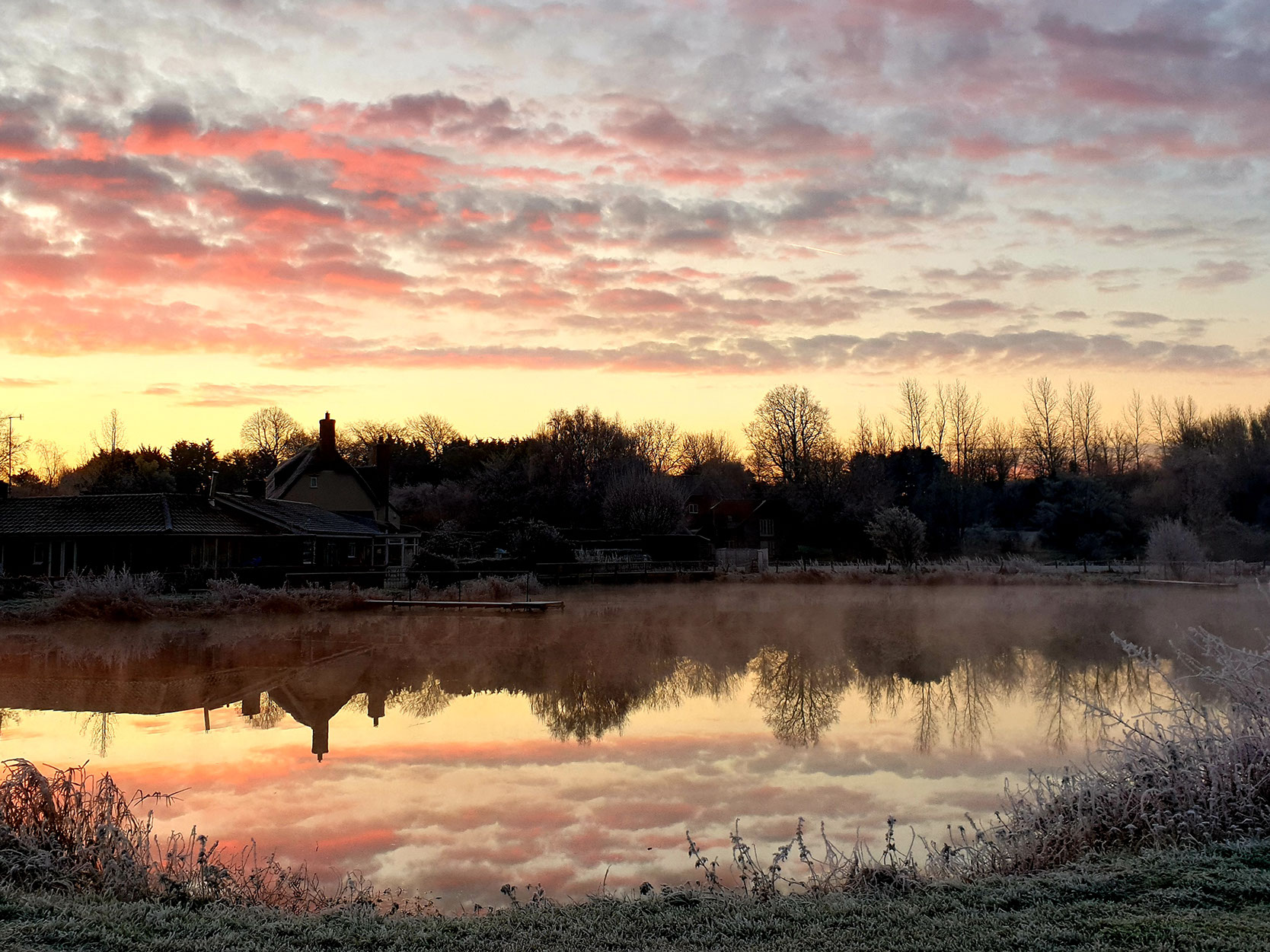AUGUST 2021
The changes to Club waters.
It is with some sadness that I report the end of the Club’s tenancy of Buggs Water on the River Stour at Charlton Marshall, which has been part of the Club’s portfolio for many years. The agreement has been terminated by the Farm with effect from the 1st September 2021. Judging from Club surveys, it has never been a heavily fished stretch of the River, but it nevertheless will, I am sure, be missed by some.
In the same context it is appropriate to remind members that the Club is giving up its arrangement for Canford Ponds with effect from the end of 2021. This has been explained previously, but in summary, the Club is simply not able reasonably continue to manage this water without help from our landlord and that has not been forthcoming.
On a positive note can I remind you that, we have signed new terms for Crooked Willows at Horton this year and that is providing good sport in a pleasant countryside setting.
The website has been updated to reflect the changes that have taken effect and the Membership Book for 2022 will reflect this new position.
By Mike Hirsh, Club Chairman
Protecting our wildlife, stock and waters
Many members will be familiar with the recent reports into the Club, regarding birds snared in fishing line. Unsurprisingly, these reports are predominantly from our open access waters, namely Creekmoor and Hatch Ponds.
What is concerning is the increase in the number of times birds are falling foul of discarded line. To be fair, the pandemic has seen Club membership numbers increasing, and for some, an increased amount of time has been available to go fishing. However, regardless of the number of folks fishing any particular venue, discarded line is unacceptable and almost always preventable.
In short, the Club risks losing access to these two waters (both leased from BPC) if birds continue to end up injured or dead as a result of broken and discarded lines.
We have put together some pointers below, aimed at newcomers to the sport in the main, but also serving as a reminder for those who would benefit from a refresher.
• It is good practice to evaluate your swim whilst setting up, for snags and potential ways your line could end up broken. Being mindful of likely underwater obstacles is also a good idea.
• Casting a lead minus your rig to the spots you intend to fish and slowly retrieving in, will give you an immediate idea of the lake bottom. This will identify weed, snags and potential obstacles. A bare lead should pass over any detritus if retrieved carefully.
• Most of us choose to cast to features within the lake e.g., islands, lily pads, overhanging trees etc. You can ensure you never cast into these by using the line clip on your reel. Simply cast short of the target, clipping your line on the process. If you peel line to the clip gradually to ensure you are getting closer to the intended spot, with zero risk of hitting it, it will minimise getting snagged and having to pull for a break.
• If you are not using a reel with a line clip designed for clipping to on the cast, a small piece of pole or marker elastic will cushion the line. Similarly, repeatedly hitting the clip on the same section of line will weaken it over time. Ensure you are cutting a few feet off between sessions if you're fishing the same swims or ranges repeatedly.
• Please ensure you are fishing properly in relation to lane strength. Fishing an 8lb or 10lb monofilament tight to the pads on Hatch Pond is not good angling. Hooked carp know their surroundings and will take you into the nearest snag almost every time. Situations like this call for beefed up tackle, such as 15lb mainline.
• When float fishing and ledgering, always have a hook-link with a lower breaking strain than your mainline. This ensures (more often than it doesn’t) that should your hook become snagged, you will only leave a small hook and small length of line in the lake, not yards and yards of line, attached to additional weights/feeders/floats etc.
• If you’re fishing close to both under and over water snags, it’s imperative you fish with your clutch or bait-runner locked up tightly. This will of course mean that your set up also needs to be anchored correctly. It is poor angling to have reels set to free spool when fishing close to obstacles. This will certainly result in snared fish, broken lines and thus added danger to resident wildfowl.
• If you are consistently fishing venues and swims, where you are always in close proximity to snags, good practice would be to select a line with a low stretch factor. You’d be amazed at how much elasticity there is in some manufacturers of line. A 30 yard cast could very easily yield one yard of stretch or more, meaning a potentially snagged fish even on a tight clutch.
• Its poor practice to fish close to snags overnight. It simply is not possible to get to your rod fast enough. Please avoid this and fish open water spots. Failing that, it is more responsible to reel in until the next morning.
• Back leads are great to use when the situation is suitable. This is not the case when fishing to snags. The angle created by using them means any sizeable fish will have more than enough surplus line to have you buried in close-by snags.
• The depth of water on your chosen spot is really important. Swans and grebes, as well as ducks will happily dive or drop down onto your spot and potentially consume your hookbait and therefore your hook and rig. Fishing in 2ft of water is fine, only if you are watching the water for the entire duration of your session and can react to such a situation immediately. If you’re not, fish in deeper water to avoid hooking resident birds.
• Dropping the lead – a contentious issue for sure. It’s often better to drop the lead when fishing near snags and weed etc. A direct line to the hook with no dangling weight will hugely increase your chances of landing your fish. Dropping the lead in open water isn’t necessary and whilst needlessly wasteful, isn’t good practice either.
• Inline leads pose slightly less of a risk than lead-clip arrangements. Consider their use for snag fishing.
• Do not fish multiple rods in tight situations. Carp often search quite methodically for food items so fishing two or three rods does not mean you will catch tow or three times the number of fish.
Whilst not an exhaustive list, following the above guidelines will ensure you are fishing safely, both for the sake of the fish and resident wildlife.
It cannot be emphasised enough how important it is to fish safely and responsibly. No-one wants to see dead, tethered birds or fish. No-one wants to see the Club lose access to waters either. Please do your bit on each session to put a stop to the volume of lines left in our lakes – and if you see poor angling from others along the above lines, don’t feel at all awkward in pointing it out to others. If you would rather avoid this you can of course contact officers of the Club.
We have a collective responsibility. Let us not allow poor angling to result in fish and bird deaths.
Thank you for reading this and to everyone who is fishing responsibly.
By James Nash, Club Media Officer
Illegal Fishing –how to report a suspected incident
In the closed season of 2021, I was contacted twice by Members about incidents which might have been illegal fishing. I also tried to have a conversation with somebody, who I also suspected was fishing illegally, but not on a Club water. Subsequently I spoke to Jim Allan, the Environment Agency Fisheries Enforcement Officer for our area about my experience.
The advice for all incidents is really the same. Whilst our Club bailiffs do a good job checking our waters to ensure that those fishing have a current Membership, fishing in the closed season or without an Environment Agency rod licence is essentially a matter for the Environment Agency. It is the EA officers (and the police) that have the necessary statutory powers to be able to demand that an EA licence is produced and in the instance of fishing in the closed season it is the EA’s officers who are empowered to take any arising prosecution.
In both the instances, where I was contacted, it was because the individuals concerned thought the Club could do a better job as the local eyes and ears. However, in both cases the incidents were not on-going at the time of the contacts and in one instance the Club did not have a legal interest in the water. So, what is the correct procedure? The simple answer is to phone the EA hotline number that is on the reverse of your rod licence:
0800 80 70 60 and report it.
The important point made to me was that if there are regular reports of illegal fishing from one location, then it is likely the EA enforcement team will make a point of putting that location on their places to visit on a regular basis. Be forensic in your report too. [Make a careful note of what the description of the individual is and what their actions are; and note what fishing method is in use]. Please also report the matter to the Club’s officials if it is on Club water, but start with the EA.
The Club, as you will be aware, has Angling Trust qualified bailiffs and one of their roles, from time to time, is to take part in joint visits with the EA enforcement officers on our waters. As a result of one of these visits earlier this year a suspect was caught spinning on the River Stour at Canford, in the closed season, and that case is moving forward with a potential prosecution.
Whilst on the subject of bailiffs and enforcement, otherwise law-abiding anglers do from time to time put themselves at risk of both EA prosecution and a breach of the Club rules, leading to potential disciplinary action for fishing with too many rods at any one time. Rod licences clearly limit the number of rods that may be in active use, and there are Club rules that also, in some instances, determine rod numbers too (see for example Rule 11 of the general rules of fishing, the rules on match fishing and those for Pinnock Lakes).
It is my intention that the next Club yearbook will include a page with the EA hot-line number and some advice on the above matters.
[The EA hotline number is the same one to use for any pollution incidents too].
By Mike Hirsh, Club Chairman
Climate Change and our part of Dorset
I receive regular weekly emails from the gov.uk notification service providing Environment Agency information. Some of it is tedious stuff about environmental permits in distant places, some is related to projects that are out for consultation and then there are regular reports about rainfall, rivers flows, water levels and migratory fish counters.
I find the regular reports on rainfall and river flows a useful framework to put into context my own monitoring of the local environment and particularly the Club’s waters. The Monthly Water Situation Report for July makes for really interesting reading.
In summary we have just had an extraordinary amount of rainfall locally. It is advised that, “monthly rainfall totals in all catchments [nationally] were classed as normal or higher for the time of year, except for three catchments in north-west England. Three-month cumulative rainfall totals ending in July were classed as exceptionally high across much of south-east and south-west England. At the end of July soils were wetter than the long-term average across much of southern England…”
“The July rainfall total for England was 78mm, which represents 133% of the 1961-1990 long term average [LTA] (125% of the 1981-2010 LTA)…….. The highest (national) rainfall total as a proportion of the LTA was over Poole Harbour and Purbeck on the south coast, with 107mm of rainfall representing 260% of the LTA for July. The three-month cumulative rainfall totals ending in July were classed as exceptionally high across much of south-east and south-west England.”
Nationally July monthly mean river flows decreased at three-quarters of the indicator sites the EA reports on, compared to June. Despite this, flows were classed as normal or higher for the time of year at nine-tenths of indicator sites. Unsurprisingly, river flows reflected the rainfall distribution across the country, with the River Stour reflecting consistently higher than normal flows.
Much of August has been characterised by unsettled conditions, with south-west England again continuing to receive substantial amounts of rain. But, as I write we are in our first really settled spell of anti-cyclone weather for a while and water levels are dropping again.
I know regulars will have noticed how many of our lakes and ponds are higher than normal as well as the River Stour. Also, it is impossible to miss how much the bankside vegetation has continued to grow due to the damp, humid conditions. Largely, in my view, due to run off carrying nutrients, water weed has continued to flourish, and this year it had a head start too due to the mild winter.
By Mike Hirsh, Club Chairman
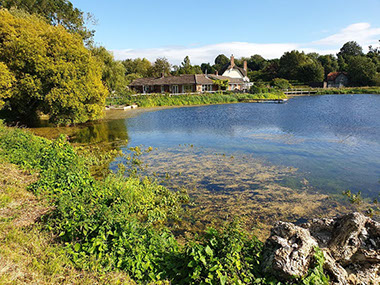
It is Winterborne Zelston that has been the most interesting water to monitor. Winterborne Zelston is fed by springs from the aquifer and boosted by the Winterborne and it quite often has stopped flowing over the outlet cill, which governs the level, by mid-June or early July. This year it stopped at the end of the first week of August and on the 17 August the level was only 18.4 cms. (seven and a quarter inches) below the cill. I have a photograph from 2016 showing the same level on the 25 June, almost two months earlier. In practical terms, it means Paul Baker, our Game Secretary has been able to stock it later in the year than I ever recall. [I am also very relieved that some planned works to stabilize the west bank were put on hold for a re-think as we need an exposed shore and at present there is none!]
So is all this rain related to global warming? I have no idea but my hunch is that it seems likely, but it also does make me think twice before the Club tries to plan further capital works. We cannot take any water levels at any time for granted. This also means we will need more Club volunteers, to pull more water weed and cut bankside vegetation, than ever before!
Winterborne Zelston on the Friday 17th August with more water than I have ever seen at this time of year.
Events and Covid-19
I thought I would update Members with some information surrounding both the lack of events this year and the proposed plans for next year.
As we are all aware the past 18 months have been both trying and restrictive with regard to the number of activities we have arranged and facilitated, we decided that it would be best to postpone events during 2021, this allowed us to ensure members safety and try and restrict any large group activities.
We have been active over the past year in helping some of our younger anglers with equipment and one-to-one support (maintaining any social distance rules that were required at the time). Through the generosity of our members and the donation of their spare and unused items of tackle together with some bequests, we have actively re-cycled tackle to young anglers to ensure they have the correct equipment to aid both the objectives of fishing safely and the welfare of our most important asset – the fish.
Next year, however, we will be back with events to engage our Members and local communities. Planning is underway to support the Angling Trust’s Building Bridges programme which works towards the successful integration of migrant angling communities in England – providing positive education and advice to help anglers understand our angling laws and customs.
We will be holding our “Let’s Go Family Fishing” project which provides fun, social and safe angling days for all ages. We provide all the equipment, not only to let families have a go at angling, but also to find out about our Club and the work we do to support the fisheries, environment and how we try to integrate with the local communities. As part of the “Let’s Go Family Fishing” we are also looking at re-running the fly-fishing event – and believe me it’s harder than it looks!!
Some of you may be aware that we also support Julia’s House with an annual, early evening of fishing, at Todber Manor. This has to be one of the most rewarding events the Club runs, with the help from a group of committed Club volunteers and coaches we make a difference to their wellbeing with fun, and a lot of fish, (I think the carers were more competitive than the kids though !!) Speaking to our volunteers after these events, they are always moved to see these children trying their absolute best and noting the joy in their sense of accomplishment in fishing, often for the first time.
We also have very close links to the BCP Council “Kids in Care” and have run events with that organisation, giving children the chance to have outside fun with their friends and relax in the environment we all enjoy so much, just sitting and watching the wildlife and catching a few fish is enough to lift their spirits.
The success of the events run is purely down to the members who give up their time to help and support the Club and ensure the next generation of anglers are as “hooked” as we are, and for that I truly am grateful.
If any Members have any tackle they no longer use please let me know and, if suitable we will up-cycle for our junior anglers,
By Sean Harris, Club Welfare Officer
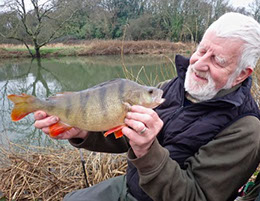
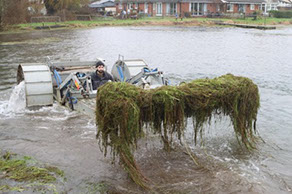
WDAC magazine discount codes
By Club Media Officer, James Nash
Members are reminded that can redeem discounts against some of the most renowned angling-related publications. Links and further information are detailed below:
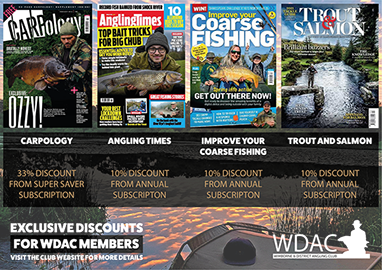
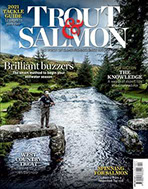
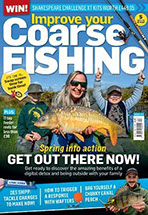
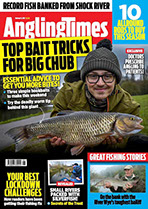
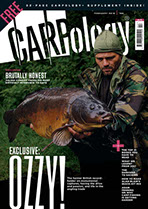
CARPOLOGY
33% discount (£22 discount)
Annual subscription deal on the super saver bundle
Code: WDAC33OFF
Carpology subscription
IMPROVE YOUR COARSE FISHING
10% discount (up to £4.90 discount)
Annual subscriptions only, minimum £35 spend
Digital or Print
Code: FISHING!
IYCF subscription
ANGLING TIMES
10% discount (up to £9.80 discount)
Annual subscriptions only, minimum £35 spend
Digital or Print
Code: FISHING!
AT subscription
SALMON AND TROUT
10% discount (up to £5.60 discount)
Annual subscriptions only, minimum £35 spend
Digital or Print
Code: FISHING!
T&S subscription
NEWS BY MONTH
DECEMBER 2025 NEWS
MAY 2025 NEWS
FEBRUARY 2025 NEWS AGM
DECEMBER 2024 NEWS
MAY 2024 NEWS
MARCH 2024 NEWS AGM
DECEMBER 2023 NEWS
MAY 2023 NEWS
MARCH 2023 NEWS AGM
FEBRUARY 2023 NEWS
DECEMBER 2022 NEWS
SOCIAL AND CONTACT
SUBSCRIBE TO OUR NEWSLETTER


TERMS AND CONDITIONS
COPYRIGHT WDAC 2024
